The Intersection of Art and History: Understanding the Past Through Creativity
-1745569774.jpg)
Art and history are deeply intertwined, with creativity serving as a lens through which we can explore the past. From the paintings adorning ancient caves to modern works that capture the essence of contemporary issues, art has been a medium for storytelling, cultural expression, and historical documentation. By examining the intersection of art and history, we gain not only an understanding of past events but also insight into the lives, beliefs, and struggles of the people who lived through them.
1. Art as a Historical Record
Before the written word became widespread, art was one of the primary ways through which humans recorded history. Early civilizations used cave paintings, sculptures, and pottery to depict their daily lives, religious beliefs, and historical events. These early artistic works provide us with valuable clues about the past, revealing details about ancient customs, tools, clothing, and even social hierarchies.
Cave Paintings: The Dawn of Human Expression
Some of the earliest known artistic creations are the cave paintings found in places like Lascaux in France and Altamira in Spain. These paintings, believed to be more than 17,000 years old, offer a glimpse into the lives of prehistoric humans. The images of animals, human figures, and symbolic marks on the cave walls give us insight into the early human experience—how people lived, what they valued, and how they interacted with the world around them.
While these artworks may not have been intended as historical records in the way we think of today, they represent a profound effort to capture moments in time. The depiction of animals and hunting scenes, for example, suggests a deep connection between early humans and their environment. These works are more than art; they are a form of communication and an early attempt at storytelling.
Ancient Art and the Depiction of Power
As civilizations developed, art began to take on a more formalized role in recording and interpreting history. Ancient Egyptians, Greeks, and Romans used art to celebrate rulers, gods, and significant events. Egyptian tomb paintings, for instance, not only depicted the lives of pharaohs and nobles but also conveyed their beliefs about the afterlife, showcasing a strong connection between art, religion, and history.
In ancient Rome, portraits of emperors and scenes of military conquest were designed to glorify the emperor’s achievements. The use of statues, mosaics, and frescoes allowed the ruling class to control the narrative of history, ensuring that their legacy would be immortalized for generations to come.
2. Art as a Reflection of Social and Political Movements
Throughout history, art has also been a powerful tool for social and political commentary. It reflects the values, struggles, and challenges of the time, often providing insight into the social climate of a particular era. Art has the ability to capture the zeitgeist—offering a window into the emotions and ideologies that shaped historical movements.
The Renaissance: Rediscovery of the Past
The Renaissance, which spanned from the 14th to the 17th century, marked a period of great cultural transformation in Europe. It was a time of rediscovery, as artists, scientists, and thinkers looked to the classical past for inspiration. The works of artists like Leonardo da Vinci, Michelangelo, and Raphael were not only revolutionary in terms of technique but also represented a return to the ideals of ancient Greece and Rome.
The Renaissance was also a period of intellectual and philosophical growth, with artists blending creativity and reason. Da Vinci’s Vitruvian Man, for example, combines art with scientific principles, reflecting the era’s fascination with the human body and the study of proportion. Through art, Renaissance thinkers sought to reconnect with the wisdom of the ancients and understand humanity’s place in the universe.
The Industrial Revolution: Art as a Response to Change
The Industrial Revolution brought rapid technological advancements and profound social changes. As factory systems grew and cities expanded, traditional ways of life were disrupted. In response to these changes, artists began to explore themes of alienation, inequality, and the dehumanizing effects of industrialization.
The works of the Pre-Raphaelite Brotherhood in England and the social realism of French artists like Gustave Courbet and Jean-François Millet focused on the lives of working-class people. These artists used their craft to critique the inequalities brought about by industrial society, highlighting the struggles of laborers and the working poor.
3. Art as a Medium for Preserving Memory and Legacy
Art often serves as a vehicle for preserving historical memory and cultural heritage. Monuments, sculptures, and paintings are designed to honor the past, whether it be through commemorating historical figures, events, or moments of collective significance.
Monuments and Memorials: Honoring History
Throughout the world, monuments and memorials have been erected to commemorate important historical events or figures. The Lincoln Memorial in Washington, D.C., for example, stands as a tribute to the legacy of President Abraham Lincoln and his role in preserving the Union during the American Civil War. Similarly, the Great Wall of China is not only an architectural marvel but also a symbol of China’s historical defense against invaders.
Artistic representations of historical events, such as the Vietnam Veterans Memorial in the United States, help to memorialize those who have made sacrifices for their country. These monuments not only honor individuals or events but also provide future generations with a sense of continuity and connection to the past.
Art and Cultural Preservation
Art is also crucial for preserving the cultural heritage of a people. Many ancient civilizations have left behind artistic treasures that continue to influence modern culture today. The art of the ancient Greeks, for example, is foundational to Western culture, while the intricate architecture and murals of the Maya civilization offer insights into their sophisticated society.
Art also plays a significant role in preserving indigenous cultures and their traditions. Through storytelling, visual art, music, and dance, indigenous artists are able to maintain their cultural practices and pass them down to future generations. In this way, art becomes an essential tool for safeguarding the cultural identity of communities around the world.
4. Art in the Modern World: Looking Back and Looking Forward
In the modern world, art continues to be an essential way of interpreting history. Whether it’s through contemporary photography, cinema, or digital art, artists are constantly reinterpreting the past, offering new perspectives on historical events.
Art and Memory in the Digital Age
Today, technology has transformed the way we engage with art and history. Digital art, virtual reality, and interactive exhibitions allow for new forms of storytelling. Museums and galleries around the world are embracing digital platforms, offering virtual tours and interactive displays that make history accessible to a global audience.
Artists today are also using technology to create immersive experiences that bring historical events to life. For example, digital art installations that recreate scenes from World War II or the Civil Rights Movement allow viewers to engage with history in a more visceral way. These modern forms of art make history tangible and relatable, helping to bridge the gap between past and present.
5. Art as a Bridge to the Past
Art is a powerful tool for understanding the past. It is not just a reflection of history but also a way to engage with it. Whether through ancient cave paintings or contemporary digital installations, art enables us to connect with the lives, struggles, and achievements of those who came before us. By exploring the intersection of art and history, we gain a deeper understanding of the forces that have shaped our world and the cultural heritage that continues to influence our lives today. In this way, art is not just a means of creative expression but also a vital tool for preserving and interpreting the human experience.

Mithila Magic: The Empowering Art of Nepali Women
-1745572320.jpg)
Preserving Culture: The Importance of Protecting Traditions
-1745569776.jpg)
Global Inspirations: The Cross-Cultural Exchange of Art
-1745569773.jpg)



-1745569762.jpg)
-1745569762.jpg)
-1745569769.jpg)
-1745569771.jpg)